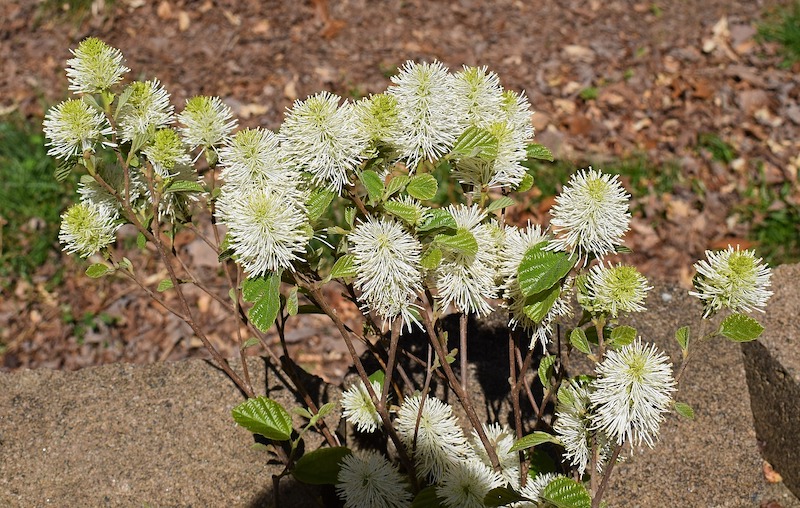Fothergilla is a genus of shrubs in the witch hazel family, Hamamelidaceae. Grown for their spring flowers and autumn colors, these low-maintenance plants lend themselves well to container planting. Dwarf fothergilla, F. gardenii, is a good candidate for containers due to its smaller size. Growing and spreading to 3-6 feet, this shrub grows nicely in large containers for areas that are tight on space. Potted fothergilla can be grown on sunny or partially shaded patios, entryways, and balconies. Even when grown in containers, these popular shrubs are easy to cultivate.

Planting Fothergilla in Pots
The best time to plant fothergilla in pots is in spring or fall when temperatures are mild and the risk of transplant shock is lower. Choose a pot that is at least twice as wide as the plant’s root ball and deep enough for the root collar – where the trunk meets the roots – to rest just above the soil line. Opt for growing fothergilla in pots made of a heavy material, resistant to cracking from fluctuations in winter temperatures, such as concrete, glazed ceramic, or metal. The pot should have some drainage holes at the bottom to prevent waterlogging. Place the pot in a location where the plant will receive full sun or partial shade.
Best Soil For Fothergilla in Pots
A well-drained potting soil rich in organic matter is best for potted fothergilla. Fothergilla needs an acidic soil with a pH of 5-6.5. Use a peat-based potting mix with perlite and backfill with an ericaceous compost at planting time. This will ensure that the pH is low enough for the fothergilla to thrive. Do not add pebbles to the bottom of the pot, as this will raise the water table and create anaerobic conditions in the soil. Mulch can be added to the top of the soil to conserve soil moisture. To prevent rot, be sure that the mulch is not piled against the bark of the plant.
Caring For Fothergilla in Planters
Caring for fothergillas in containers and planters is only slightly different from growing fothergillas in the ground. These shrubs need little maintenance, as they are slow growing and adaptable to a variety of conditions.

Watering Fothergilla in Pots
Fothergilla grown in pots will need to be watered more often than a fothergilla grown in the ground. Keep the soil consistently moist throughout the entire growing season, allowing it to dry out slightly in between waterings. Fothergilla will need to be watered during periods of drought. Check the soil daily during hot, dry periods, especially if the fothergilla is planted in full sun. Reduce watering if rainfall is abundant or if the pot is placed in a shadier location. Empty any water that collects in the drainage tray.
Fertilizing Fothergilla in Pots
Container-grown fothergilla benefits from fertilization to encourage a faster rate of growth. Because fothergilla grows in acidic soils, it will need to be fertilized with a formula that is made for acidic-loving plants such as rhododendrons. If using a slow-release, granular fertilizer, apply it to the soil just once in spring. Water the fothergilla well after fertilizing to prevent fertilizer burn and to distribute the nutrients to the roots. Compost is another option for providing nutrients to fothergilla in containers. Fothergillas are not heavy feeders and will not need to be fertilized often if the soil they are grown in is rich in organic matter.
Winter Care For Fothergilla in Pots
Fothergilla grown in pots will need winter protection. Move potted fothergilla to a place where it will be sheltered from harsh winter winds, such as an unheated garage or shed. If your pot is too heavy to move, you can insulate the soil by applying 2-3 inches of mulch to the top of the pot. Wrap the sides of the pot with a few layers of burlap. Avoid overwintering fothergilla in clay or terracotta pots, as these may crack and break over winter. Water your fothergilla deeply in late fall and throughout the winter before a freeze is expected.
Growing Fothergilla Indoors
Fothergilla should not be grown indoors as a houseplant. Native to temperate regions of the eastern United States, these shrubs have evolved to undergo a cold, dormant period once winter starts. These deciduous plants perform best when they are grown outside and are able to complete their life cycle according to seasonal cues and changes.
 |
Lauren Youngcourt - Published 06-23-2023 |
